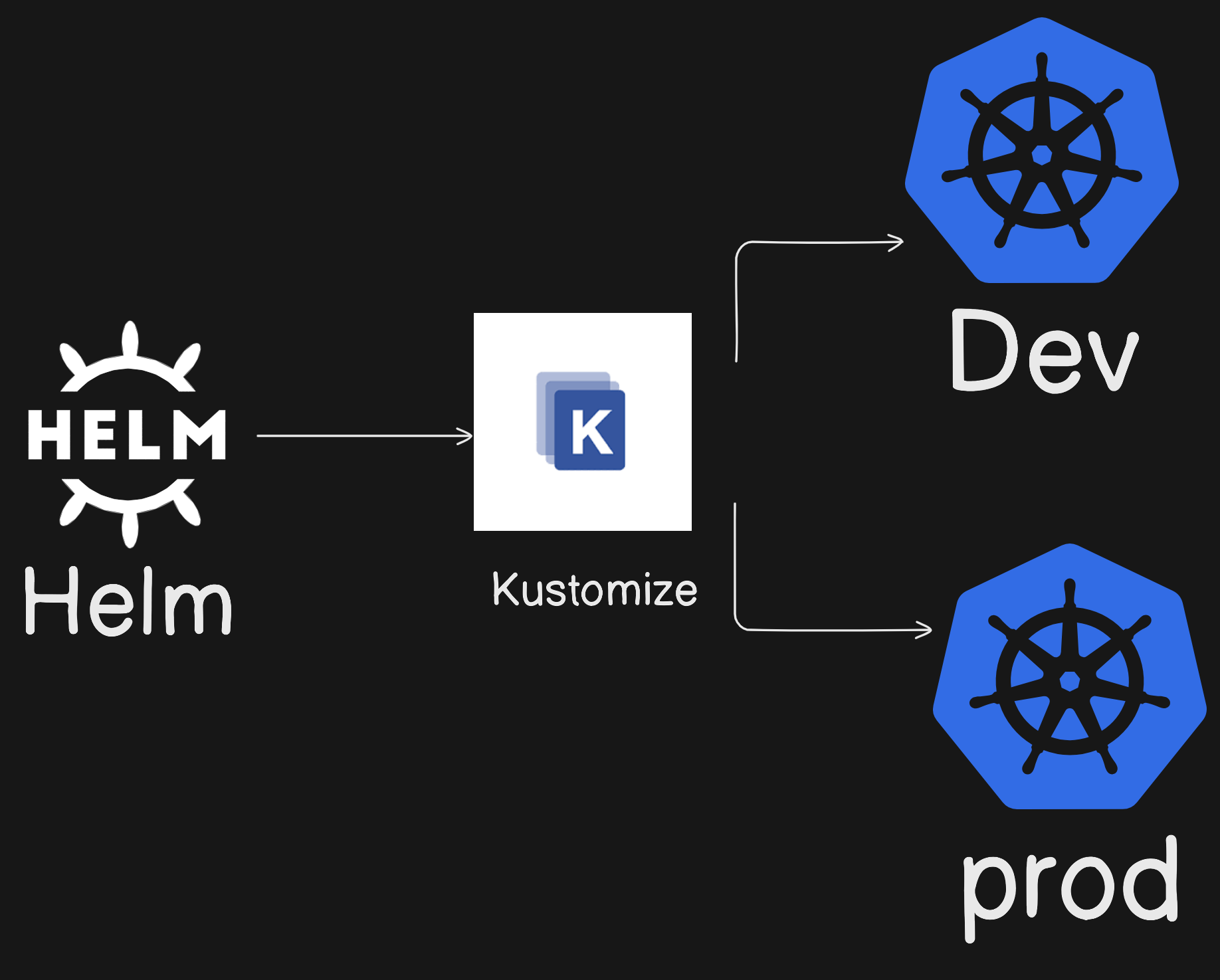How to use Helm charts with Kustomize for managing multiple environments
 DiptoChakrabarty
DiptoChakrabarty
In the previous blog we saw how to build our custom charts using helm to package our applications.
This is about how we can make use of kustomize to use the same chart for deploying in different environments.
Files for the blog can be found here.
Build a helm chart first with the helm command
helm create ziggy
Run the following commands to view if your chart is rendering properly
helm template web ./ziggy
I am only going to make use of the deployment , service and pods so all other templates I am going to delete.
Once done we want to ensure we can run our charts in two separate environments.
We create two directories
one to store our generated template from helm and run kustomize on it.
one to store the configurations for prod and dev.
mkdir manifest overlays
manifest will store the generated helm output on which we will run kustomize.
overlays stores the configurations for dev and prod.
Run the following command to generate the helm chart output
helm template web ziggy > manifest/backend.yaml
This generates the helm files for using
---
# Source: ziggy/templates/service.yaml
apiVersion: v1
kind: Service
metadata:
name: web-ziggy
labels:
helm.sh/chart: ziggy-0.1.0
app.kubernetes.io/name: ziggy
app.kubernetes.io/instance: web
app.kubernetes.io/version: "1.16.0"
app.kubernetes.io/managed-by: Helm
spec:
type: ClusterIP
ports:
- port: 80
targetPort: http
protocol: TCP
name: http
selector:
app.kubernetes.io/name: ziggy
app.kubernetes.io/instance: web
---
# Source: ziggy/templates/deployment.yaml
apiVersion: apps/v1
kind: Deployment
metadata:
name: web-ziggy
labels:
helm.sh/chart: ziggy-0.1.0
app.kubernetes.io/name: ziggy
app.kubernetes.io/instance: web
app.kubernetes.io/version: "1.16.0"
app.kubernetes.io/managed-by: Helm
spec:
replicas: 1
selector:
matchLabels:
app.kubernetes.io/name: ziggy
app.kubernetes.io/instance: web
template:
metadata:
labels:
app.kubernetes.io/name: ziggy
app.kubernetes.io/instance: web
spec:
securityContext:
{}
containers:
- name: ziggy
securityContext:
{}
image: "nginx:1.16.0"
imagePullPolicy: Always
ports:
- name: http
containerPort: 80
protocol: TCP
livenessProbe:
httpGet:
path: /
port: http
readinessProbe:
httpGet:
path: /
port: http
resources:
{}
Under manifests we define our kustomize file
resources:
- "backend.yaml"
Now we proceed to work on the overlays which contains our environment configurations for dev and prod.
Create two directories dev and prod and here are the following changes we are going to perform.
change the deployment , service and pod names for each environment.
set different resource limits and requests based on dev or prod.
The kustomization file under overlays/dev will look something like this
resources:
- "../../manifest/"
patches:
- path: ./patch-deploy.yaml
target:
kind: Deployment
- path: ./patch-service.yaml
target:
kind: Service
- path: ./patch-pod.yaml
target:
kind: Pod
The resources section references the kustomization.yaml in the manifest directory where our helm output is stored.
patches refers to the files to consider for patching and associated resource types.
patch-deploy.yaml
- op: replace
path: /metadata/name
value: dev-ziggy-deployment
- op: add
path: /spec/template/spec/containers/0/resources
value:
limits:
cpu: "0.5"
memory: "512Mi"
requests:
cpu: "0.2"
memory: "256Mi"
We replace the name of the deployment and add a resource limit and request for the deployments since in the original file we haven't added it.
The patch-service.yaml and patch-pod.yaml
- op: replace
path: /metadata/name
value: dev-ziggy-service
- op: replace
path: /metadata/name
value: dev-ziggy-pod
In a similar fashion we define for our prod directory with the only change being in the patch-deploy.yaml
- op: replace
path: /metadata/name
value: prod-ziggy-deployment
- op: add
path: /spec/template/spec/containers/0/resources
value:
limits:
cpu: "3.0"
memory: "2Gi"
requests:
cpu: "1.0"
memory: "1Gi"
other than changing the name we assign higher cpu and memory allocation.
We store our generated files in a result directory , the command to generate is as follows
kustomize build overlays/dev > result/dev-result.yaml
The generated dev and prod results are as follows
dev-result.yaml
apiVersion: v1
kind: Service
metadata:
labels:
app.kubernetes.io/instance: ziggy
app.kubernetes.io/managed-by: Helm
app.kubernetes.io/name: ziggy
app.kubernetes.io/version: 1.16.0
helm.sh/chart: ziggy-0.1.0
name: dev-ziggy-service
spec:
ports:
- name: http
port: 80
protocol: TCP
targetPort: http
selector:
app.kubernetes.io/instance: ziggy
app.kubernetes.io/name: ziggy
type: ClusterIP
---
apiVersion: apps/v1
kind: Deployment
metadata:
labels:
app.kubernetes.io/instance: ziggy
app.kubernetes.io/managed-by: Helm
app.kubernetes.io/name: ziggy
app.kubernetes.io/version: 1.16.0
helm.sh/chart: ziggy-0.1.0
name: dev-ziggy-deployment
spec:
replicas: 1
selector:
matchLabels:
app.kubernetes.io/instance: ziggy
app.kubernetes.io/name: ziggy
template:
metadata:
labels:
app.kubernetes.io/instance: ziggy
app.kubernetes.io/name: ziggy
spec:
containers:
- image: nginx:1.16.0
imagePullPolicy: Always
livenessProbe:
httpGet:
path: /
port: http
name: ziggy
ports:
- containerPort: 80
name: http
protocol: TCP
readinessProbe:
httpGet:
path: /
port: http
resources:
limits:
cpu: "0.5"
memory: 512Mi
requests:
cpu: "0.2"
memory: 256Mi
securityContext: {}
securityContext: {}
prod-result.yaml
apiVersion: v1
kind: Service
metadata:
labels:
app.kubernetes.io/instance: web
app.kubernetes.io/managed-by: Helm
app.kubernetes.io/name: ziggy
app.kubernetes.io/version: 1.16.0
helm.sh/chart: ziggy-0.1.0
name: prod-ziggy-service
spec:
ports:
- name: http
port: 80
protocol: TCP
targetPort: http
selector:
app.kubernetes.io/instance: web
app.kubernetes.io/name: ziggy
type: ClusterIP
---
apiVersion: apps/v1
kind: Deployment
metadata:
labels:
app.kubernetes.io/instance: web
app.kubernetes.io/managed-by: Helm
app.kubernetes.io/name: ziggy
app.kubernetes.io/version: 1.16.0
helm.sh/chart: ziggy-0.1.0
name: prod-ziggy-deployment
spec:
replicas: 1
selector:
matchLabels:
app.kubernetes.io/instance: web
app.kubernetes.io/name: ziggy
template:
metadata:
labels:
app.kubernetes.io/instance: web
app.kubernetes.io/name: ziggy
spec:
containers:
- image: nginx:1.16.0
imagePullPolicy: Always
livenessProbe:
httpGet:
path: /
port: http
name: ziggy
ports:
- containerPort: 80
name: http
protocol: TCP
readinessProbe:
httpGet:
path: /
port: http
resources:
limits:
cpu: "3.0"
memory: 2Gi
requests:
cpu: "1.0"
memory: 1Gi
securityContext: {}
securityContext: {}
Kustomize can play a even more powerful role for managing helm charts for advanced features, however with git ops it is possible to streamline this to a greater extent.
If you would like to know more about that please follow my newsletter.
Subscribe to my newsletter
Read articles from DiptoChakrabarty directly inside your inbox. Subscribe to the newsletter, and don't miss out.
Written by
